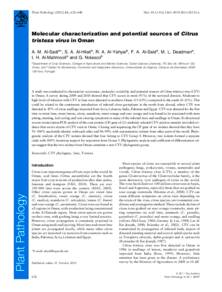Document
Endemic and emerging vector-borne Mediterranean citrus diseases and their epidemiological consequences.
Identifier
DOI: 10.2174/978160805294311201010137
Contributors
Catara, Antonino., Author
Publisher
Bentham Science Publishers.
Gregorian
2010-01
Language
English
Subject
English abstract
The chapter presents a brief historical account on citrus cultivation in the Mediterranean basin and on major epidemics that affected citriculture in the past. The citrus industries mostly survived these serious drawbacks by changing about 150 years ago their horticultural practices from non-grafted to grafting trees on the sour orange rootstock which produced a stionic combination highly resistant to fungal root-rots. Basing the industry on the sour orange eventually turned into the road map for the emergence of a subsequent major global pandemic caused by the aphid borne Citrus tristeza virus (CTV). This led growers to shift to new stionic combinations based on a variety of rootstocks that provided not only tolerance to the disease along with adaption to a variety of edaphic conditions. Adaptability is an ongoing process as recently experienced in certain parts of Brazil, where the Rangpur lime rootstock which for almost half a century has been successfully providing both drought and CTV tolerance is succumbing to a recent localized epidemic caused by citrus sudden death, a new vector borne disease caused by an infectious agent that is still not sufficiently characterized. Rootstock replacement is however not an universal remedy for all citrus mainly because some threatening diseases such as greening /huanglobing (HLB), Citrus variegated chlorosis (CVC), witches broom and stem pitting isolates of CTV damage directly the scion part and thus not helped by rootstock-replacement. The chapter focuses on three vector-borne pathogenic agents that cause three important citrus diseases, stubborn, CTV and citrus greening/HLB respectively representing three types of disease problems (i) endemic, (ii) emerging and (iii) threatening of concern for Mediterranean growers. Some possible ways to minimize the damaging impacts of these diseases on the future of citrus production in the Mediterranean Region are discussed and some measures validated by past experience with endemic disease are used to obtain an estimate on the potential damage of two disease problems threatening the Mediterranean citrus industries, the spread of Toxoptera citricidus, the most effective vector of CTV and the possible spread and emergence of greening/HLB epidemic in the area. Information on other vector born citrus diseases as citrus variegated chlorosis, citrus sudden death, citrus leprosis, Omani lime witches broom disease, in relation to their potential threats to Mediterranean citriculture is provided. Essentially the message is simple and follows the slogan "better safe than sorry" as a clear indication that the Mediterranean citrus industries must place high priorities both on national and regional certification and R&D programs to prevent the spread of these potentially devastating diseases.
Member of
ISBN
978-160805680-4
Resource URL
Category
Book



